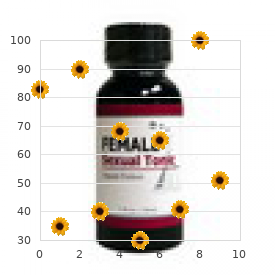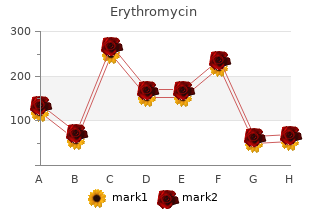Erythromycin
"Effective erythromycin 500 mg, antimicrobial effects of silver nanoparticles".
By: Z. Marik, M.B. B.A.O., M.B.B.Ch., Ph.D.
Clinical Director, University of Missouri–Kansas City School of Medicine
Making the diagnosis of hypothermia is a challenge because most of the early signs are the normal physiological response to antibiotic ingredients buy erythromycin online now the stress of trauma and haemorrhage; the surgeon should be particularly attentive to antibiotic for sinus infection starts with l order erythromycin discount the presence of shivering and tremors infection and immunity purchase erythromycin paypal. With even greater hypothermia the patient becomes unconscious; bradycardia and bradypnoea are pronounced; urine output fails; and ventricular fbrillation resistant to defbrillation occurs. Re-warming should continue until a core temperature of at least 33� C before pronouncing death. Please note: these high risk factors are partly intrinsic to the patient and partly iatrogenic. Management Treatment begins with active measures of prevention during frst aid and evacuation: the casualty must be kept warm!. The patient must be sheltered from cold and wind, relieved of wet clothing, and covered with a dry blanket or sheet, even in a tropical climate. In hospital, active preventive measures must continue: the emergency room should be kept thermo-neutral (28� C for an adult) and, after the patient has been undressed, examined, and resuscitative measures begun, covered with a blanket. The impact of the latter should not be underestimated: the patient starts of dry and warm and ends up wet and hypothermic. Under muscle relaxant anaesthesia, a patient can no longer shiver and is particularly at risk. Since 20 � 30 % of body heat is lost through the head and neck, keeping these body parts warm is a priority. The rest of the body, apart from the operative site, can equally be wrapped in dry towels and secured with plastic bags to preserve heat. Operating time should be kept as short as possible; an open abdomen or thorax inevitably entails loss of body heat which is just as critical at this stage as blood loss. Fluids and blood can be heated by being placed in a tub of hot water, comfortable to an elbow touch. All of these simple measures, which do not require 18 sophisticated equipment, should be standard procedure in all surgical patients, especially those sufering from trauma. Not only will these simple measures prevent hypothermia, but their early implementation will help treat the condition. Again: rare is the haemorrhaging trauma patient with a core temperature below 32� C who survives, however good the surgery. Full resuscitation and haemodynamic stability in a warm patient, assuring good tissue perfusion, is the best antidote. Amongst the intrinsic ones, the most important include: � extensive tissue injury, which releases tissue factors resulting in consumption coagulopathy (with reduced platelet count), excessive fbrinolysis, and activation of infammatory cascade; � activation of the C-reactive protein infammatory cascade independently of the release of tissue factors and entirely due to the shocked state and tissue hypoperfusion; � haemodilution resulting from the mobilization of extravascular fuids as a homeostatic response to shock; � decrease in the total and ionized calcium concentrations; and � the efects of progressive hypothermia and acidosis. The severity of the coagulopathy seems to parallel the severity of injury and shock. Coagulopathy itself is often exacerbated by clinical practice in a �bloody vicious cycle�. Bleeding and coagulation times remain prolonged despite adequate replacement of blood, plasma and platelets if the patient remains hypothermic. These efects do not help overcome early tissue hypoxia in spite of the increase in haemoglobin. In addition, the glucose in stored blood is slowly metabolized with production of lactate and fall in the pH, exacerbating the acidosis. Warm whole blood, as fresh as possible, is probably the best treatment; and, as often repeated in this manual, in conditions of limited resources is often all that is available. With numerous potential donors (family and friends), it may be possible to build up a small reserve. Intravenous calcium should be administered, separately and at least one ampoule added per two units of blood transfused. Coagulopathy also attends many patients with severe head injury, and a damage control approach is applicable to injuries to most body systems. Volume 2 will include relevant observations in the discussion of war injuries to the diferent anatomic regions. Chirurgie d�urgence en situation precaire [Emergency Surgery under Precarious Circumstances]. London: International Association for Trauma Surgery and Intensive Care, Hodder/Arnold; 2007. Geneva: International Committee of the Red Cross and International Federation of Red Cross and Red Crescent Societies; 2004.



Schwarz (1994) stated this position forcefully: Many purported demonstrations of cognitive shortcomings occur because basic assumptions that underlie all social discourse in everyday settings are �routinely violated� in studies on judgmental biases treatment for sinus infection uk purchase erythromycin 500mg with mastercard. Amplification of dilution by accountability could be consistent with either a judgmental heuristics or conversational-norm interpretation antimicrobial keyboard covers buy generic erythromycin. Following a procedure developed by Schwarz (1994) antibiotics for acne oily skin discount 500 mg erythromycin visa, some subjects were told that the axioms of conversation applied: the experimenter had screened the information to ensure its relevance for the prediction task. Other subjects were told that the research team could not vouch for the usefulness of the information as it had been randomly selected from a computer database. If dilution is a rational response to conversational norms, the effect should disappear when conversational norms have been deactivated explicitly. Moreover, accountability should cease to magnify the dilution effect when conversational norms have been deactivated. By contrast, if dilution is the product of a judgmental heuristic that involves automatic similarity-matching of causes and effects, there is less reason to expect explicit deactivatation of conversational norms to moderate either the magnitude of the dilution effect or the tendency for accountability to amplify it. Consistent with a conversational-norms interpretation, dilution disappeared among accountable subjects who thought that conversational norms did not apply. Accountability also ceased to motivate more complex patterns of thinking when conversational norms had been deactivated. By contrast, dilution persisted among subjects who had been told that conversational norms do apply, as well as among subjects in a no-normprimed control condition, who were told nothing about the relevance of the information. Contrary to the conversational-norm hypothesis, however, and consistent work with a judgmental-heuristics interpretation, deactivating conversational norms was not sufficient to eliminate dilution among unaccountable subjects. The judgmental-heuristic and social-functionalist explanations need not, of course, be mutually exclusive. Indeed, whenever accountability amplifies a given error or bias, the two classes of processes may well be mutually reinforcing. Plausible-candidate effects include not only dilution, but also the compromise, attraction, and reason-augmentation effects (Shafir et al. Consider the reason-augmentation effect, in which �enriched options,� which possess both more positive and more negative features, are more likely to be selected when decision makers are asked to choose their preferred option, but less likely to be selected when decision makers are asked to reject their less-preferred option. This phenomenon is consistent with a view of decision makers as intuitive politicians who, prior to deciding, weigh the relative justifiability of response options, but do so in a superficial manner such that when they are asked to choose an option, they count the number of good reasons for doing so, and when they are asked to reject an option, they count the number of reasons for doing that (thereby short-circuiting the need for complex compensatory comparisons). Taboo Trade-offs: Defective Intuitive Economist or Principled Defender of Sacred Values. Since the times of Adam Smith, scholars have commented on people�s reluctance to acknowledge certain value trade-offs and their occasionally fierce opposition to the very notion of a unified utility metric on which people weigh certain values against others. Traditional cognitive explanations emphasized the difficulty of working through apple�orange comparisons that cut across qualitatively different dimensions of value. Interdimensional comparisons can be difficult, but they are not typically cause for moral outrage. We do not usually find it shameful to admit that we make trade-offs between money and the wine or meat or leisure time that we consume. Indeed, it is not only acceptable to think in complex compensatory terms about one�s household budget; we expect, even require, such trade-offs of all competent, self-supporting adults in competitive-market economies (Becker, 1996). The guiding idea is that our commitments to other people require us to deny that we can compare certain things quantitatively. To transgress this normative boundary, to attach a monetary value to one�s friendships or to one�s children or to loyalty to one�s country, is to disqualify oneself from certain social roles, to demonstrate that one does not have the faintest idea of what it means to be a true friend or parent or scholar (�You just don�t get it�). We experience constitutive incommensurability whenever treating values as commensurable subverts one of the values in the trade-off calculus; to compare is to destroy. Merely thinking about certain trade-offs degrades one�s standing as a moral being. Durkheim expressed the same sentiment in more sociological language when he observed that in both �primitive religious� and �advanced secular� societies, people ascribe a transcendental quality to the fundamental values of their social order. It is as though they need to believe that these values are infinitely important and cannot be compromised.

Partial work disability virus computer erythromycin 500 mg on-line, defned as any change in job duties or reduction in work hours due to antibiotics for acne prone skin buy 250mg erythromycin fast delivery asthma antibiotic natural generic erythromycin 250 mg with amex, has been described in 5% to 20% of adult asthmatics attending specialist clinics. The work impact appears to be even more dramatic among the subset of adults with occupational asthma. Multiple studies conducted in various countries have shown that immunological occupational asthma is associated with considerable professional and fnancial consequences: 25�38% of subjects with occupational asthma sufer prolonged work disruption and 42�78% report a substantial loss of income. A number of vocational and sociodemographic factors adversely afect employment and socioeconomic status in workers with occupational asthma; these include unskilled jobs, lower levels of education, older age or younger age, a lower number of economically-dependent subjects and being employed in small-sized frms. Interestingly, the clinical severity of asthma does not appear to be an important determinant of employment status in subjects with occupational asthma. In the only available study that compared immunological occupational asthma with non-work-related asthma, the rate of unemployment was similar in the two groups, whereas a reduction of income was more frequently reported by subjects with occupational asthma (62%) as compared with those with asthma unrelated to work (38%). The socioeconomic impact of work-aggravated asthma symptoms has received relatively little attention given the potential magnitude of the problem. The results of the few available studies show that, even in the absence of occupational asthma or irritant-induced asthma, work aggravated asthma is associated with a considerable socioeconomic impact. Available information indicates that fnancial compensation for occupational asthma is currently inadequate in European countries, since about one third of subjects with occupational asthma remain exposed to the agent causing their asthma in order to avoid or minimise the adverse fnancial efects that would result from complete avoidance of exposure. It appears that the rate of unemployment is lower among subjects with occupational asthma in Quebec (25%) than in other countries despite removal from exposure of all afected workers. This lower rate of unemployment is coincident with a higher proportion of workers who beneft from professional retraining programs (22%) and/or fnd another job with the same employer (31% versus 15�21%). Extrapolating from this limited information, compensation schemes might be more efective to the extent that they can be redirected toward facilitating relocation into non-exposed jobs in the same company or retraining for other jobs rather than providing inadequate fnancial compensation. Furthermore, to be more equitable, compensation should ensure more appropriate income replacement when relocation or professional rehabilitation brings about a loss of earnings. Evidence Asthma is the most prevalent cause of respiratory ill health during working life but most of the literature on asthma is about primary or secondary synthesis prevention by controlling exposure or medical treatment. There is no clear evidence on the efcacy of breathing exercises for the rehabilitation of asthma or other respiratory disorders, but general pulmonary rehabilitation can improve exercise capacity and quality of life, and education in asthma self-management coupled with regular medical review can improve health outcomes, including days of work. Evidence There is general clinical consensus that return to (suitably controlled) work is an appropriate and desirable goal for many people with respiratory synthesis conditions. There is strong evidence that prevention of further exposure is fundamental to the clinical management and vocational rehabilitation of occupational asthma. Overall, the reviewers concluded that there is insufcient evidence to determine whether psychological interventions for adults with asthma help to improve symptoms and mental health. Two small studies reported school/work absenteeism but showed no signifcant efect on this outcome. P hysi ian Thisguide highlightsthe keyrole oftreatingphysi iansand the im portanc e of ollab oration and oordination ofm anagem entw ith otherkey guidanc e stakeholders. The physi ian hasaresponsib ilityto understand the patient� srole in the w orkplac e and to supportsafe and tim elyreturn to w orkasthe desired outom. Thisinc ludesresponsib ilityto: assess diagnose; treatdevelopareturn to w orkplan; m onitor progress provide reports om m uni ate w ith the patientotherhealth professionals, relevantauthoritiesand em ployerand preventrec urrenc. M n o discipl in ary r ul tidiscipl in ary back pain guidel in es w can we ach ieve a co n essage in prim ary care. P arti ipants W orkshopreport in thisw orkshop ontrib uted to an open disc ussion on �how and w hy� evidenc e b ased guidelinesab outb ac kpain do ordo notw orkin prac ti. H ow to share the evidenc e and m ake itm eaningful to prac ti e stakeholdersisthe m ain hallenge ofguideline im plem entation. Guidelines should b e developed and m onitored b yam ultidisc iplinaryteam b utm ayb e transferred to prac ti e b ym ono disc iplinarym essengers. D espite general agreem entthatm ultifac eted interventionsare m ostef ec tive forim plem entingguidelines, the feasib ilityofdoingthisin b usy lini al settingsisquestioned. Researh isneeded from loc al im plem entation pilotsand qualitym onitoringstudiesto understand how to developand deliverthe ontextual understandingrequired. Thisrelatesto proc essesof are asw ell asoutom es, and to soc ial fac torsand poli ym akingas w ell ashealth are interventions. The m ajorityofuniversitiessurveyed overed m usc uloskeletal issues, how ever notevery ourse ould identifyw hatthey overed forw orkrelated m usc uloskeletal disorders. The foc usgroupsand questionnaire identif ed thatthe m ajorityoftrainingin m usc uloskeletal disordersw asduringthe registraryearsb y ontinuousM edi al Educ ation. When om paring m anagem entw ith the evidenc e review ed, good prac ti e w asidentif ed in anum b erofdisordersb utthisw asnotalw ays onsistentW ith regard to diagnosis, dif use non spec if c upperlim b disordersw ere asan issue.

Syndromes
- Complete physical exam, including nervous system exam
- Dislocation of the artificial joint
- Tires easily
- Surgery to remove it
- The wire that connects the stimulator to the lead in the brain breaks through the skin (this usually only occurs in very thin people)
- Watching for the return of symptoms, and knowing what to do when they return
- A small, flexible tube (catheter) will be inserted through this cut into one of the blood vessels in this area. The doctor uses live x-ray images to carefully guide the catheter up into your heart.

On this account virus 007 purchase generic erythromycin on-line, there is no reason to nosocomial infection cheap 250 mg erythromycin specially privilege the food vehicle as the original source of contagion bacteria 400x magnification 500mg erythromycin overnight delivery. Widespread avoidance of physical contact with or close proximity to ill or dead people suggests the possibility that the core issue in the origin of contagion is microbial contamination, whatever the source. The third account does not attribute the origin of contagion to negative, microbial effects, but rather to positive effects. Although the relative weakness of positive contagion suggests that it might be an accidental overextension of the negative contagion principle, it is also possible that positive contagion has its own origin or adaptive value. An obvious function for positive contagion is in the support of kin relations and love bonds. It could well function to strengthen important blood bonds, with their obvious link to fitness. Sharing food is a particularly common behavior that centers on kin-related groups, and sexual intimacy involves highly contagious contact. Positive contagion includes valuing objects that belonged to and were in contact with ancestors, living loved ones, or greatly admired persons; Grandmother�s ring, food prepared by a loved one, or Princess Diana�s clothing are salient examples. The relative weakness of positive contagion could be simply a result of the negativity dominance discussed previously. Alternatively, it could be a result of the fact that positive contagion virtually always competes with illness risk and disgust. The microbial risks of intercourse are well illustrated by sexually transmitted diseases. A deep kiss involves exchange of saliva, which is both a disgusting body fluid and a potential disease vector, when examined out of the context of love or lust (Nemeroff, 1988; Nemeroff & Rozin, 1994, 2000). A final account of the origins of contagion is based in the work of Johnson and Lakoff. Our bodies, they say, provide us with preconceptual structures that shape our abstract thoughts. Body movements and perceptual interactions with the world, which are fundamentally based in the experience of having a human body, give rise to �image schemata� that are �metaphorically projected� to structure our domains of thought. By this account, the contagion principle would arise from our phenomenological experience of our bodies as containers (having an inside, a boundary, and an outside), combined with other schemas such as trajectory, force, links, and so on. This account easily explains the breadth of magical contagion, although it does not address the negativity bias. Given some initial locus for the origin of contagion, an account is still needed for the great breadth of contagion in contemporary humans. The problem of the spread of contagion is paralleled by the spread of disgust from its likely original food origin to a wide range of elicitors, including interpersonal contacts and especially contacts with ill or immoral persons. The range of disgust in contemporary humans overlaps substantially with the range of contagion. Indeed, our definition of disgust invokes contagion as a critical feature: Contact with a disgusting substance renders an otherwise acceptable entity. Our account of the cultural evolution of disgust invokes the process of preadaptation; that is, the application of an adaptation that evolved for one purpose to a new purpose. We trace the cultural evolution of disgust as an expansion of elicitors from its origin as a response to distasteful foods through reactions to offensive foods, other animal properties of our existence. The extension of contagion could have occurred by this same type of process, whatever its origins. Of course, once contagion became linked to disgust, either in origin or later on, its domain could have spread as the domain of disgust spread. We commonly ask people why they reject juice that had brief contact with a cockroach. The answer almost always refers to toxins and microbes; the diseasegenerating properties of the roach. This, of course, relates to some of the views we have expressed about the microbial origins of contagion. However, in the laboratory, we often follow up this response by repeating the process with a new glass of juice, now contaminated by a sterilized roach � that is, a germfree roach just removed from an autoclave.
Buy erythromycin on line. Science Bulletins: MRSA—The Evolution of a Drug-Resistant Superbug.

